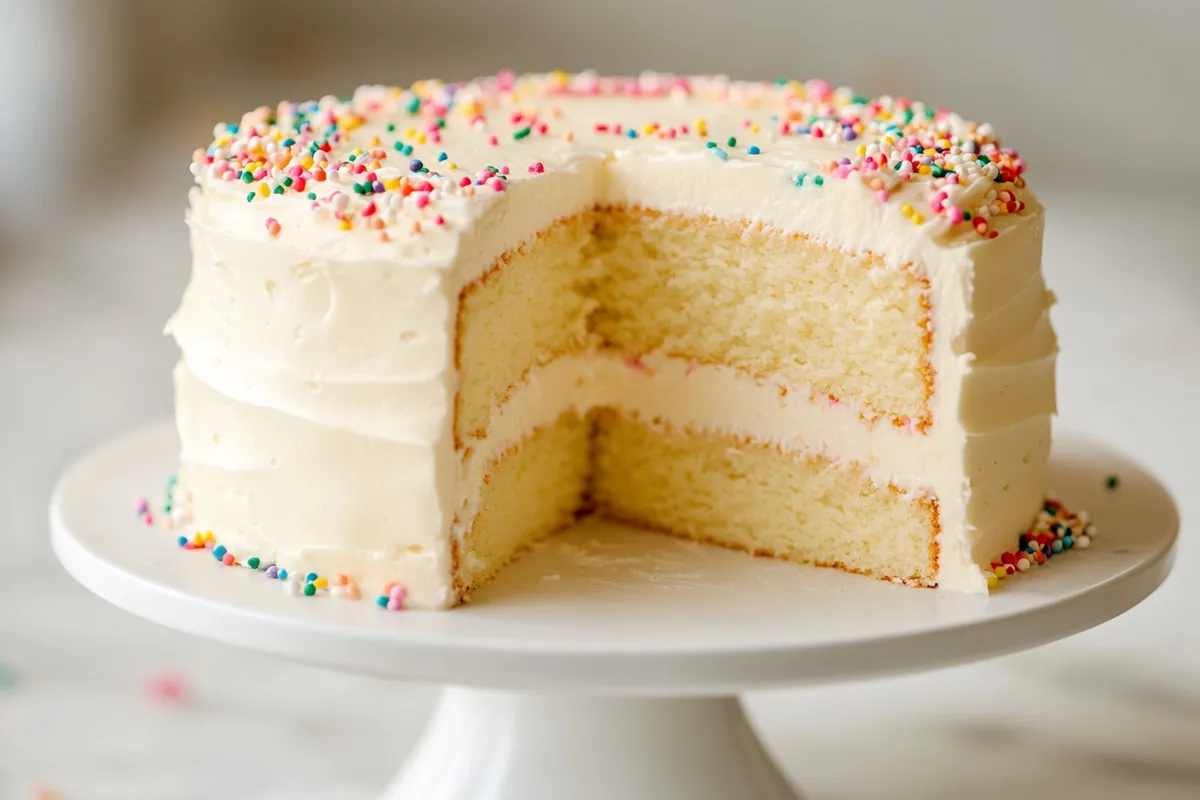If you’re looking for a vanilla cake recipe that’s soft, moist, and packed with rich vanilla flavor, you’ve come to the right place. This simple yet foolproof recipe will guide you through every step to create the perfect homemade vanilla cake. Whether it’s for a birthday, celebration, or just because, this cake will become your go-to dessert.
If you love classic cakes, you might also enjoy trying our Tres Leches Cake Recipe—a deliciously soaked sponge cake that melts in your mouth. For chocolate lovers, our Chocolate Cherry Cake offers a rich and fruity twist. And if you’re curious about unique flavors, check out What is a Mary Jane Cake? to discover a lesser-known but equally delightful treat.
With detailed instructions, expert baking tips, and a nutritional breakdown, you’ll master this recipe in no time. Let’s get baking!
Why This is the Best Vanilla Cake Recipe
With countless vanilla cake recipes out there, here’s why this one stands out:
Soft, Fluffy, and Moist Texture
This cake has the perfect balance of light and airy yet rich and moist. The secret? Proper ingredient ratios, room-temperature dairy, and the right mixing technique to prevent a dense texture.
Rich and Authentic Vanilla Flavor
We use pure vanilla extract or vanilla bean paste for a deep, natural sweetness—no artificial flavors. The result is a warm, aromatic vanilla taste in every bite.
Easy and Foolproof Recipe
Designed for both beginners and experienced bakers, this recipe follows a simple method with clear step-by-step instructions to ensure success every time.
Versatile and Perfect for Any Occasion
This cake pairs well with buttercream, fruit fillings, or chocolate ganache. Whether it’s for birthdays, weddings, or a simple treat, this recipe is customizable and always a crowd-pleaser.
Now, let’s dive into the step-by-step process of making this classic vanilla cake.
Step-by-Step Guide to Making the Perfect Vanilla Cake
1. Preparing the Ingredients
Before you start, gather and measure everything accurately. Proper preparation ensures a smooth baking process.
Ingredients
- 2 ½ cups (310g) cake flour (or substitute with all-purpose flour)
- 2 ½ teaspoons baking powder
- ½ teaspoon salt
- 1 cup (226g) unsalted butter, softened
- 2 cups (400g) granulated sugar
- 4 large eggs, room temperature
- 1 tablespoon pure vanilla extract
- 1 cup (240ml) whole milk, room temperature
2. Mixing the Batter
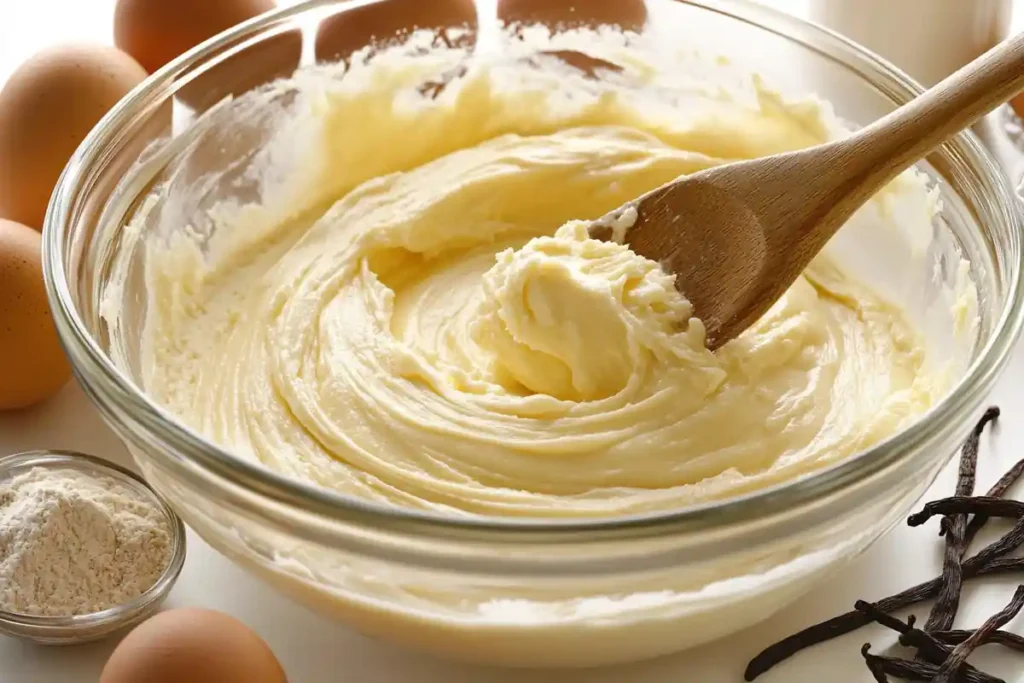
The way you mix your ingredients affects the final cake texture. Follow these steps carefully:
- Cream Butter and Sugar – In a large mixing bowl, beat 1 cup butter and 2 cups sugar together until pale and fluffy. This incorporates air into the batter, making the cake light.
- Add Eggs One at a Time – Mix in 4 large eggs, one at a time, beating well after each addition to ensure proper emulsification.
- Sift and Add Dry Ingredients – In a separate bowl, sift together 2 ½ cups cake flour, 2 ½ teaspoons baking powder, and ½ teaspoon salt. Gradually add this mixture to the wet ingredients, mixing gently to avoid overworking the batter.
- Add Milk and Vanilla – Slowly pour in 1 cup whole milk and 1 tablespoon vanilla extract, mixing until just combined. The batter should be smooth and slightly thick.
3. Preparing the Cake Pans
Properly preparing your pans prevents sticking and promotes even baking.
- Grease and Line the Pans – Use butter or non-stick spray, then line the bottom with parchment paper.
- Lightly Dust with Flour – This adds an extra non-stick layer. Tap out excess flour before pouring in the batter.
4. Baking the Cake
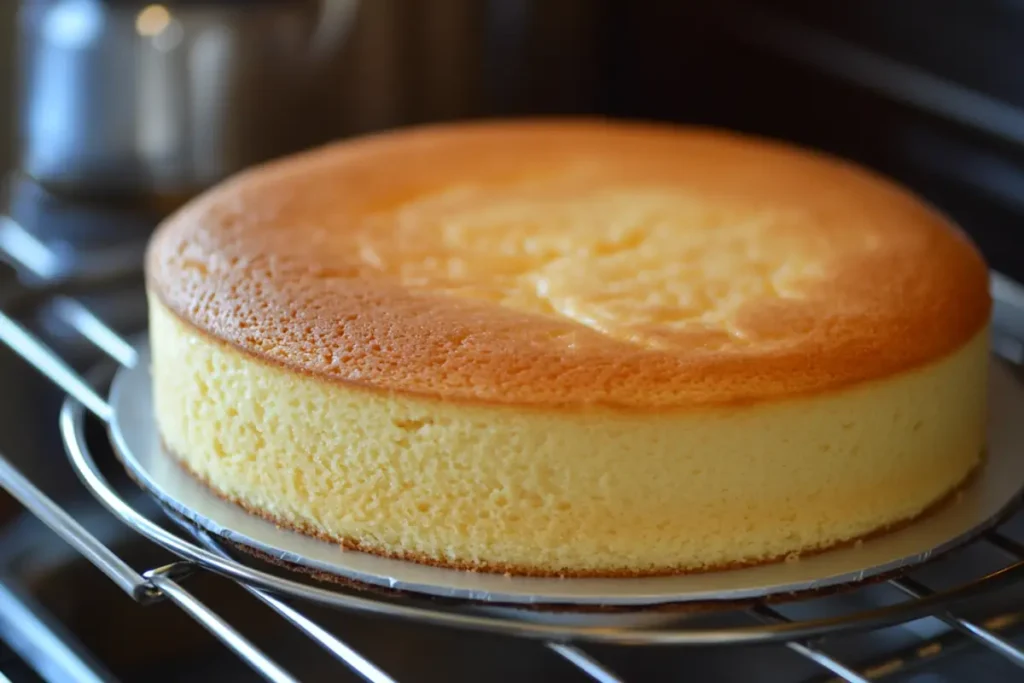
Timing and temperature are key to a perfect bake.
- Preheat the Oven – Set it to 350°F (175°C) and let it heat up fully.
- Pour the Batter – Divide evenly between the prepared cake pans and smooth the tops.
- Bake for 25-30 Minutes – The cakes are done when a toothpick inserted into the center comes out clean.
- Cool the Cakes – Let them rest in the pans for 10 minutes, then transfer to a wire rack to cool completely before frosting.
5. Frosting and Decorating
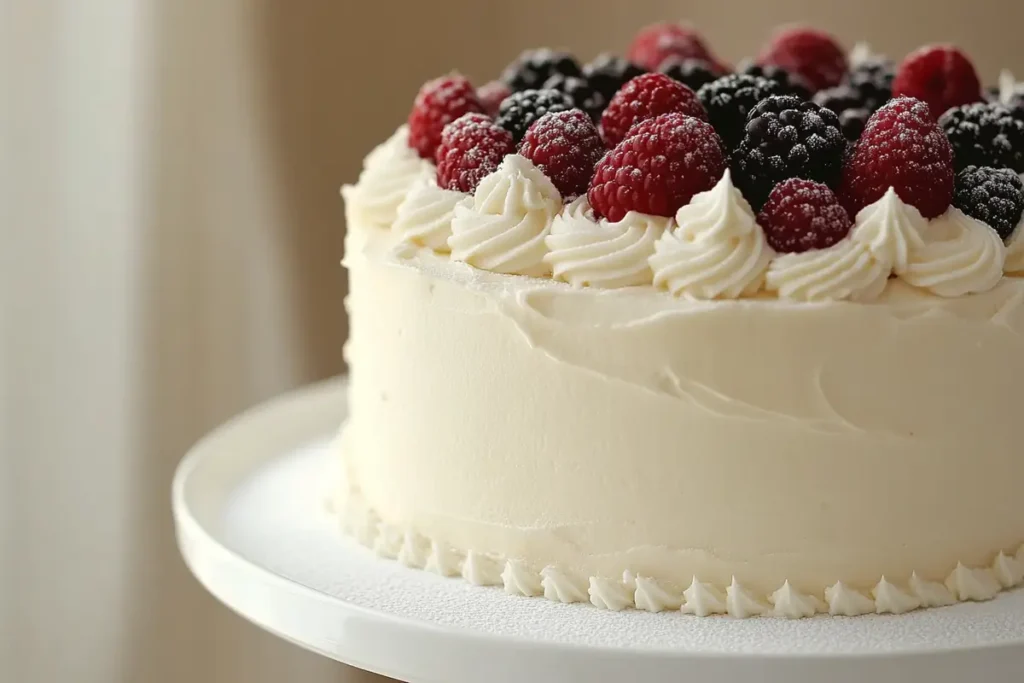
Now comes the fun part—decorating your cake.
- Choose a Frosting – Classic buttercream, cream cheese frosting, or whipped ganache all work beautifully.
- Assemble the Cake – Place one layer on a plate, spread frosting, then add the second layer.
- Decorate – Add sprinkles, berries, or a drizzle of melted chocolate for an elegant finish.
Nutritional Information
Here’s a breakdown of the nutritional values per serving:
Nutritional Facts per Serving
| Nutrient | Amount per Serving |
|---|---|
| Calories | 320 kcal |
| Carbohydrates | 45g |
| Protein | 5g |
| Fat | 14g |
| Saturated Fat | 8g |
| Sugar | 30g |
| Fiber | 1g |
| Sodium | 180mg |
| Cholesterol | 60mg |
(These values may vary based on frosting and additional toppings.)
Pro Tips for the Best Vanilla Cake
Want to bake a fluffy, moist, and bakery-style vanilla cake every time? Follow these four essential tips for guaranteed success.
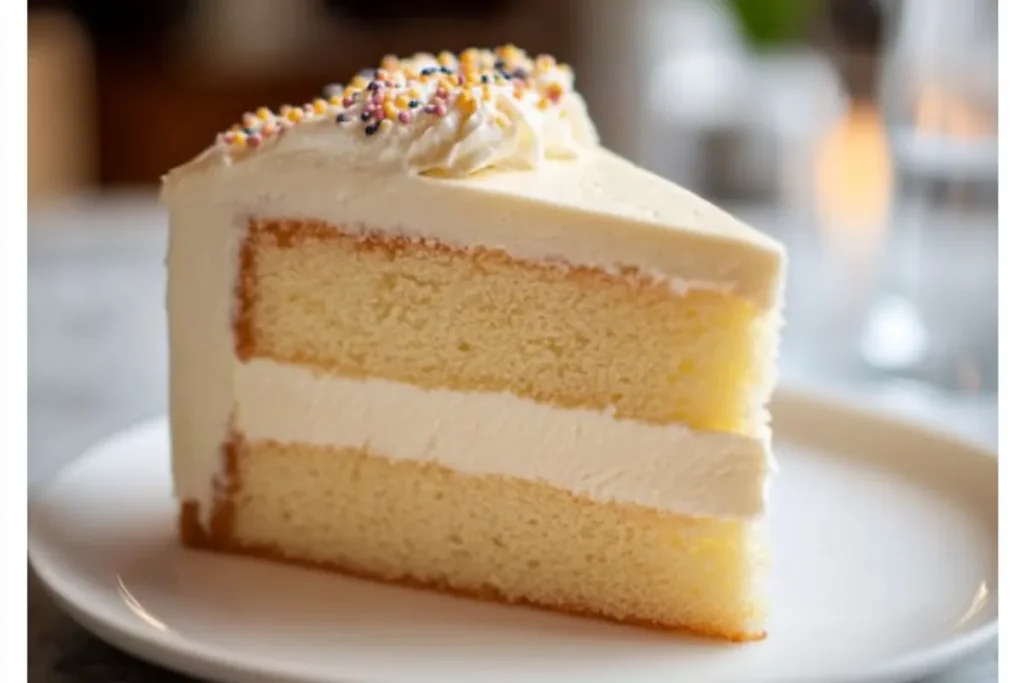
1. Use Room Temperature Ingredients
Cold butter, eggs, and milk don’t mix well, leading to a dense cake. Always bring your ingredients to room temperature before baking to ensure a smooth batter and even texture.
2. Measure Ingredients Accurately
Baking is a science! Use a kitchen scale for precise measurements. When measuring flour, spoon and level instead of scooping directly to prevent a dry cake.
3. Avoid Overmixing the Batter
Overmixing develops too much gluten, making the cake tough instead of soft. Mix just until combined—once the flour disappears, stop stirring!
4. Don’t Overbake
A dry cake is usually overbaked. Start checking 5 minutes before the recommended time, and use the toothpick test—it should come out clean or with a few moist crumbs.
By following these four expert tips, your vanilla cake recipe will turn out light, fluffy, and absolutely delicious every time!
Common Mistakes and How to Avoid Them
Even experienced bakers encounter cake disasters. Here’s how to troubleshoot common vanilla cake issues and ensure success.
1. Why Is My Cake Dense?
A dense cake is often caused by:
- Overmixing – Mix only until combined.
- Too much flour – Measure using the spoon-and-level method.
- Expired baking powder – Make sure it’s fresh.
To test baking powder freshness, mix 1 teaspoon with ½ cup of warm water. If it fizzes immediately, it’s still good!
2. Why Didn’t My Cake Rise?
If your cake is flat, these could be the reasons:
- Expired leavening agents – Baking powder and baking soda lose potency over time.
- Oven too cool – If not hot enough, the cake won’t rise properly.
- Overmixing – This can collapse the air bubbles needed for a fluffy texture.
3. Why Is My Vanilla Cake Cake Dry?
A dry cake can ruin the experience. Here’s how to avoid it:
- Overbaking – Always check early.
- Not enough liquid – Use the correct ratio of milk and eggs.
- Too much flour – Ensure accurate measurements.
To rescue a dry cake, brush it with simple syrup (equal parts sugar and water heated until dissolved) to add moisture before frosting.
4. Why Did My Cake Stick to the Pan?
If your cake won’t come out cleanly:
- Grease, line, and flour the pan before adding batter.
- Let the cake cool slightly before trying to remove it.
- Run a knife around the edges to loosen it before inverting.
FAQs
Can I make this cake without eggs?
Yes. You can substitute eggs with unsweetened applesauce, yogurt, or mashed bananas.
Why did my vanilla cake turn out dense?
Overmixing the batter or using cold ingredients can make the cake dense. Always mix gently and use room-temperature ingredients.
Can I store this vanilla cake for later?
Yes. Store in an airtight container at room temperature for up to 2 days or refrigerate for up to 5 days. You can also freeze it for up to 3 months.
Can I use this recipe for cupcakes?
Absolutely. Reduce the baking time to 18-22 minutes for perfectly moist vanilla cupcakes.
If you tried this recipe, let me know in the comments! Happy baking!
Print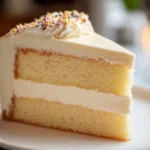
Vanilla Cake Recipe – Fluffy and Absolutely Delicious
- Total Time: PT40M-45M
- Yield: 10 servings 1x
Description
This Vanilla Cake is soft, fluffy, and packed with rich vanilla flavor. Perfect for birthdays, celebrations, or any occasion, this foolproof recipe will be your go-to dessert.
Ingredients
2 1/2 cups (310g) cake flour (or all-purpose flour substitute)
2 1/2 teaspoons baking powder
1/2 teaspoon salt
1 cup (226g) unsalted butter, softened
2 cups (400g) granulated sugar
4 large eggs, room temperature
1 tablespoon pure vanilla extract
1 cup (240ml) whole milk, room temperature
Instructions
-
Preheat & Prep:
Preheat the oven to 350°F (175°C). Grease and flour a 9×13 inch (23×33 cm) baking pan. -
Mix Dry Ingredients:
In a bowl, whisk together flour, baking powder, and salt. -
Prepare Wet Ingredients:
In a separate bowl, beat sugar and eggs until light and fluffy. Gradually mix in milk and vanilla extract. -
Combine:
Slowly fold the dry ingredients into the wet mixture, stirring gently until just combined. Do not overmix. -
Bake:
Pour the batter into the prepared pan and bake for 30-35 minutes, or until a toothpick inserted in the center comes out clean. -
Cool & Poke:
Let the cake cool for 10 minutes, then poke holes all over the surface using a fork or toothpick. -
Make Milk Mixture:
In a bowl, whisk together evaporated milk, condensed milk, and heavy cream. -
Soak:
Slowly pour the milk mixture over the cooled cake, ensuring even absorption. -
Chill:
Cover and refrigerate for at least 4 hours, preferably overnight. -
Frost & Serve (Optional):
Whip heavy cream, powdered sugar, and vanilla extract until soft peaks form. Spread over the cake before serving.
Enjoy your Tres Leches Cake!
Notes
- For extra flavor, use vanilla bean paste instead of extract.
- Ensure all ingredients are at room temperature for a smooth batter.
- To keep the cake moist, brush layers with simple syrup before frosting.
- Prep Time: PT15M
- Cook Time: PT25M-30M
- Category: Dessert
- Method: Baking
- Cuisine: American
Nutrition
- Serving Size: (per serving, without frosting)
- Calories: 320 kcal
- Sugar: 30 g
- Sodium: 180 mg
- Fat: 14 g
- Saturated Fat: 8 g
- Carbohydrates: 45 g
- Fiber: 1 g
- Protein: 5 g
- Cholesterol: 60 mg
Keywords: tres leches cake, moist sponge cake, Latin American dessert, three milk cake, easy dessert recipe

